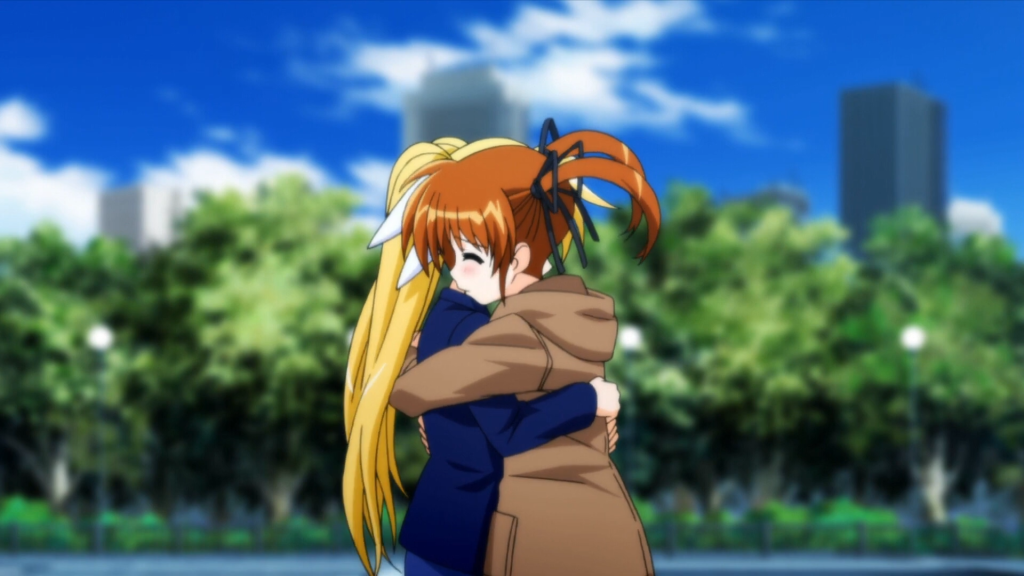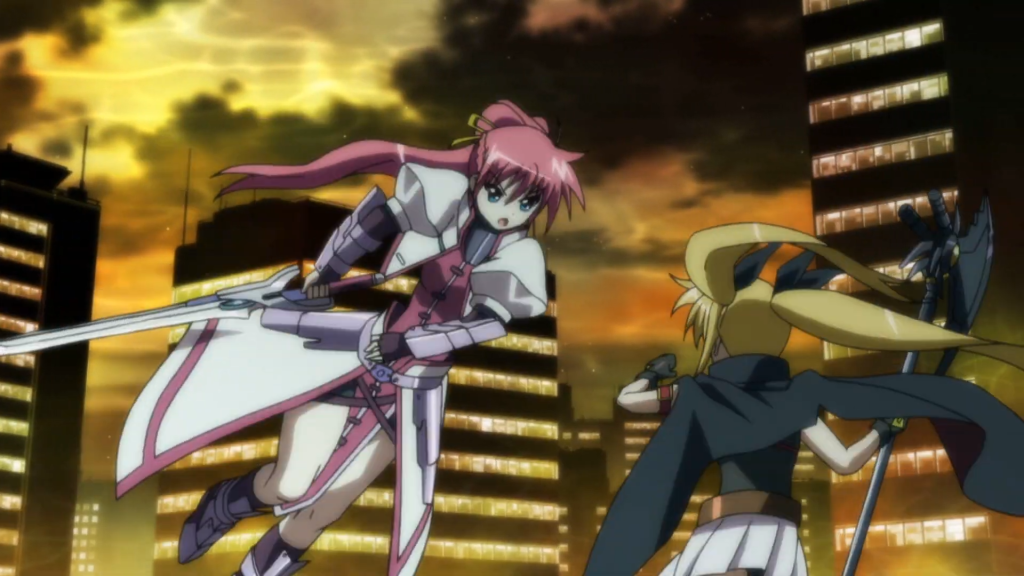This year, I thought I’d try something a bit different with these. First off, I’m not going to bother with nominees. It occurs to me that having different nominees is only really helpful if I announce those in advance. Secondly, I’ll be hosting a “reader’s choice” awards. I’ll list every single anime I’ve reviewed this year, sorted alphabetically, in the comments section leave your own choices for the various awards. For those of you who are regular readers from AFT, I’ll be posting a special thread for you to use. You can vote for however many categories you want. They can be anything that actually relates to the award in question, regardless of whether or not I liked/disliked them. To give a few examples, Futari Wa Precure: Max Heart won’t be eligible for the various film reviews & Corpse Party isn’t eligible for the comedic awards, because it has to be deliberately funny to be in the running for those. For your convenience, I’ve labelled all of the film reviews.
So, here’s our list of anime reviewed:
3×3 Eyes Seima Densetsu, Akuma no Riddle, All Purpose Cultural Cat Girl Nuku Nuku: Dash, Ankoku Cat, Appleseed (film), Cardcaptor Sakura: the movie (film), Choujigen Game Neptune: The Animation, Choujuu Densetsu Gestalt, Code Geass: Hangyaku no Lelouch, Conqueror of Shamballa (film), Corpse Party: Tortured Souls, Death Parade, Divergence Eve, Dragonball Z: Fusion Reborn (film), Exlorer Woman Ray, Futari wa Precure: Max Heart, Gankutsuou, Ginga Ojou-sama Densetsu Yuna, Gintama, Glass no Kamen, Gochuumon wa Usagi Desu ka, Hetalia: Paint it White (film), Hoshi wo ou Kodomo (film), Ice, Kannazuki no Miko, Kara no Kyoukai 6 (film), Kara no Kyoukai 7 (film), Kekkai Sensen, Kigurumikku V3, Kyattou Ninden Teyandee, Love Hina, Love Hina Again, Love Live, Love Live 2, Mahou Shoujo Lyrical Nanoha As, Mahou Shoujo Lyrical Nanoha StrikerS, Mahou Shoujo Lyrical Nanoha Vivid, Mars of Destruction, Miyamoto Musashi: Souken ni Haseru Yume (film), Mushishi, Natsu no Arashi 2, Night Walker: Mayonaka no Tantei, Overlord, Phantom: Requiem for the Phantom, Sengoku Otome: Momoiro Paradox, Shigofumi, Shinrei Tantei Yakumo, Solty Rei, Spirited Away (film), Strike Witches, Sunabouzu, Uchuu Kyoudai, Whisper of the Heart (Film), Wooser no Sono Higurashi, X-men, Yahari Ore no Seishun Love Comedy wa Machigatteiru, Yuru Yuri 2, Yuru Yuri San Hai
Now that that’s taken care of, let’s go over my personal choices for this year’s awards.
The Moffat Award for unbearably awful writing within a supposedly mostly serious series or OVA. Previous winners: Dansai Bunri no Crime Edge & Neon Genesis Evangelion
This year’s Moffat award winner is, from Madhouse, X-men.

You’re probably thinking, “really, Ktulu? You’ve reviewed Mars of Destruction, Ice & Corpse Party: Tortured Souls this year, but X-men stands out as the worst?” Yes, yes it does. Don’t get me wrong, all of these are terrible in their own right, but there are two things that makes X-men worse than those other three, for me. The first is that it’s the longest. Which gives it more time for its stupidity. The second is that I have a bigger attachment to X-men than I do those other series. I’ve never played the games that Corpse Party & Mars of Destruction are based on nor have I read the novel that Ice is based on. Maybe they’re good and the anime versions butchered them, maybe they’re just as bad. What I have read are a lot of X-men issues. As written by Chris Claremont, this is easily one of my favourite super hero teams. Which makes seeing them written as badly as they are in this series particularly infuriating.
The Simone Award for writing excellence is a mostly serious series or OVA. Our previous winners were Psycho Pass & Ghost in the Shell: Stand Alone Complex.
This year the Simone award goes to Mahou Shoujo Lyrical Nanoha StrikerS.
![[Coldlight]_Mahou_Shoujo_Lyrical_Nanoha_StrikerS_15_DVD[H264][3ADB5E3A].mkv_snapshot_11.59_[2015.11.19_15.45.58]](https://ktulusreviews.files.wordpress.com/2015/11/coldlight_mahou_shoujo_lyrical_nanoha_strikers_15_dvdh2643adb5e3a-mkv_snapshot_11-59_2015-11-19_15-45-58.jpg)
This one was tough to decide with StrikerS, Mushishi & Death Parade all in the running, but, in the end, StrikerS is the one I have the most fondness for by a very slight margin.
The Abrams Award for Horrendous film writing. Our previous winners were End of Evangelion & Metropolis.
This year the Abrams Award goes to Hetalia: Paint it White.

As fond as I am of the series itself, the film was a lazy drudge with recycled gags and basically nothing good that was actually original for the franchise.
The Miyazaki Award for stellar film writing. Our previous winners were Nausicaa & Kara no Kyoukai 4.
This year’s Miyazaki award goes to Spirited Away.

An excellent film from Studio Ghibli and the best I’ve watched this year.
The Macfarlane award for most failed comedy. Our prior winners were OreImo & Kill la Kill.
This year, the Macfarlane award goes to Sunabouzu.

A series that treated rape as uproariously funny and consistently found new ways to defy good taste and be genuinely one of the worst things I’ve ever seen.
The Pratchett award for comedic excellence. Our previous winners were Bottle Fairy & Doki Doki Precure.
This year’s Pratchett award goes to Yuru Yuri San Hai.

It was difficult to choose between this and the second series of Love Live but, ultimately, San Hai came out on top by the slightest of margins.
The Meyer award for worst written romance. Our previous winners were OreImo & Mawaru Penguindrum.
This year’s Meyer award goes to Love Hina Again.

Have you ever wanted to see a love triangle with a guy, his sister and the girl who abuses him? If you answered in the affirmative, I question your mental health. But that’s what Love Hina Again provides.
Next up we have the Kanemaki award for greatest romance. The previous winners of this one were Btooom & Mahou Shoujo Lyrical Nanoha.
This year, the Kanemaki award goes to Mahou Shoujo Lyrical Nanoha StrikerS.
![[Coldlight]_Mahou_Shoujo_Lyrical_Nanoha_StrikerS_14_DVD[H264][CE1A7136].mkv_snapshot_21.52_[2015.11.18_15.56.16]](https://ktulusreviews.files.wordpress.com/2016/02/coldlight_mahou_shoujo_lyrical_nanoha_strikers_14_dvdh264ce1a7136-mkv_snapshot_21-52_2015-11-18_15-56-16.jpg)
They had a fantastic budding romance in the first series. In StrikerS, they have a stellar mature romance. Nanoha and Fate are a spectacular couple.
The Anno award for flattest, most uninteresting cast. Previous winners were End of Evangelion & Neon Genesis Evangelion.
This year it goes to Love Hina Again.

The only reason that Sunabouzu didn’t take this one is that its characters are supposed to be unlikable. That’s the joke. Love Hina gives us a bunch of characters we’re supposed to like, because… they’re one-dimensional and obnoxious and Love Hina Again lowers the bar by adding in the incestuous sister character.
The Moore award for best cast. Our previous winners were Sailor Moon & Rainbow: Nisha Rokubou no Shichinin.
This year’s Moore award goes to Death Parade.

Death Parade gives us a group of characters who are highly endearing and have a lot to them. Both in terms of major characters and in terms of one episode characters.
The Bendis award for worst major conflict. The previous winners were From up on Poppy Hill & Sword Art Online.
This year’s Bendis award goes to Ice.

Ice is a series where the main conflict really doesn’t work even in concept. We have a future with only women. we have two major factions. One wants to save humanity, but not with the tested, functional methods we have to let two women reproduce with one another. They want to use some convoluted nonsense. We also have another group that hates science because it’s a man’s field (Nothing insulting to all the female scientists out there at all) and just wants to let everything end while they indulge in hedonism. Both of these groups are insufferably stupid and it makes their conflict really uninteresting.
The Claremont award for most compelling conflict. Our previous winners for this one are Psycho Pass & Shingeki no Kyojin.
This year’s Claremont award goes to Mahou Shoujo Lyrical Nanoha A’s.

What makes this conflict so good is that the antagonists are really endearing and have an incredibly sympathetic motivation. You want to see Nanoha & Fate pull through, but you also want the guardian knights to come out okay. You’re legitimately torn between the groups and it makes the conflict really compelling.
The Liefeld award for visual ineptitude. Our previous winners were Aku no Hana & Amada anime Series: Super Mario Brothers.
This year, we’re doing something a bit different and giving two out. One for the film category and the other for the series/OVA category. Our winners are Dragonball Z: Fusion Reborn & Corpse Party: Tortured Souls.

In the case of Fusion Reborn, the big artistic failing is that the action sequences are weak, which is pretty sad when you have something as action-oriented as Dragonball. In Tortured Souls the big issue is that it looks goofy. The gore effects are overblown to the point of absurd and the monsters just look silly. The artwork takes scenes that are supposed to be intense and makes them unintentionally hilarious.
Next we have the Urbino award for visual excellence. Our previous winners were Nausicaa & Tokyo Godfathers.
This year, there will be two. One for the film category & one for the series/OVA category. Our winners are Spirited Away & Mushishi.

Both of these works are really well detailed with some stellar nature scenes and they just look really superb.
The Spencer award for acting incompetence. Our previous winners were the English dub of Sailor Moon & Neon Genesis Evangelion.
This year, the Spencer award goes to Ice.

Ultimately, Ice suffers from casting several girls who can’t act in major roles and from Ishida Akira’s worst performance. In spite of him being a genuinely good actor.
The Sir Stewart award for impeccable acting. Our previous winners were Black Rock Shooter (OVA) & Mahou Shoujo Lyrical Nanoha.
This year’s Sir Stewart award goes to Glass no Kamen.

What makes this series stand out are the multiple performances from Kobayashi Sanae & Yajima Akiko as their characters don different asks for the stage. They have to play their own characters, plus the characters their characters are playing and they have to do all of it really well for the series to work. Which they do, brilliantly.
The Perry award for ear-splitting awful music. Our previous winners were the English dub of Sailor Moon & Street Fighter II.
This year’s Perry award winner is Mars of Destruction.

As much as I love classical music, Mars of Destruction uses it in a very shoddy way, not bothering to match the music to what’s happening on screen. That, in addition to the crappy sound mixing, makes it the worst.
Our final award is the Kloss award for loveliest music. The previous winners were Slayers Perfect & K-on: The Movie.
This year’s Kloss award goes to Love Live series 2.

The music in this series really is spectacular and the way the actresses harmonise is superb.
So, those are my choices this year. Feel free to leave a comment with your choices from the list or you can e-mail me at ktuluthedarkone@hotmail.com. Thanks for following me this year and I hope you’ll continue to do so in the following year, even when our tastes are very different. In two weeks I’ll post the reader’s choice winners. Have a happy Valentine’s all.





![[Coldlight]_Mahou_Shoujo_Lyrical_Nanoha_StrikerS_15_DVD[H264][3ADB5E3A].mkv_snapshot_11.59_[2015.11.19_15.45.58]](https://ktulusreviews.files.wordpress.com/2015/11/coldlight_mahou_shoujo_lyrical_nanoha_strikers_15_dvdh2643adb5e3a-mkv_snapshot_11-59_2015-11-19_15-45-58.jpg)





![[Coldlight]_Mahou_Shoujo_Lyrical_Nanoha_StrikerS_14_DVD[H264][CE1A7136].mkv_snapshot_21.52_[2015.11.18_15.56.16]](https://ktulusreviews.files.wordpress.com/2016/02/coldlight_mahou_shoujo_lyrical_nanoha_strikers_14_dvdh264ce1a7136-mkv_snapshot_21-52_2015-11-18_15-56-16.jpg)













![[Coldlight]_Mahou_Shoujo_Lyrical_Nanoha_StrikerS_10v2_DVD[H264][E4A98905].mkv_snapshot_13.24_[2015.11.25_12.00.35]](https://ktulusreviews.files.wordpress.com/2015/11/coldlight_mahou_shoujo_lyrical_nanoha_strikers_10v2_dvdh264e4a98905-mkv_snapshot_13-24_2015-11-25_12-00-35.jpg)